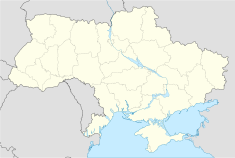- Dniester Pumped Storage Power Station
-
Dniester Pumped Storage Power Station Location of Dniester Pumped Storage Power Station Country Ukraine Location Sokyriany Coordinates 48°30′49″N 27°28′24″E / 48.51361°N 27.47333°ECoordinates: 48°30′49″N 27°28′24″E / 48.51361°N 27.47333°E Status Partially operational Construction began 1983 Commission date 2009-2017 Owner(s) Ukrhydroenergo Reservoir information Upper reservoir Dniester Upper Reservoir capacity 38,800,000 m3 (31,456 acre·ft) Lower reservoir Dniester HPP-I Dam Reservoir capacity 70,000,000 m3 (56,750 acre·ft) Pumped-storage station information Generating units 7 x 324 MW reversible Francis turbines Hydraulic head 38.7 m (127 ft) Power generation information Installed capacity 324 MW Maximum capacity 2,268 MW The Dniester Pumped Storage Power Station is a pumped storage hydroelectric scheme that uses the Dniester River 8 km (5 mi) northeast of Sokyriany in Chernivtsi Oblast, Ukraine. Currently, one of the seven 324 MW generators is operational and when complete, the power station will have an installed capacity of 2,268 MW.
Contents
Background
As part of the Dniester Hydro Power Complex, the pumped storage power station (PSP) was planned in the 1970s along with two dams (Dniester I & II) and a nuclear power plant. In 1983, Dniester II, a dam which creates the PSP's lower reservoir, was completed. The PSP was approved by 1988 and construction began that same year. Three years later in 1991 though, construction was suspended due to a funding fallout from the dissolution of the Soviet Union. The project was re-approved in 1993 and construction commenced again in 2001. Project costs increased due to the poor state of the existing facilities which were not maintained while the project was suspended.[1] On December 22, 2009, the PSP's first generator was commissioned. The second and third generators of the first stage are expected to be operational in 2011 and 2012, respectively.[2] Ukraine's problems funding the project have been compounded by controversy surrounding the project's transparency and impacts on the environment and water flow to Moldova downstream.[1] Ukraine had sought funding from the World Bank who, in 2007, only funded US$29.6 million towards the PSP's electrical transmission system.[3] Industry experts believe Ukraine will be able to complete the project independently.[4] The power station is expected to be fully operational in 2017.[5]
Design and operation
The power station begins operation by using reversible turbines to pump water, during low energy demand periods, from the lower reservoir which is created by the Dniester HPP-II Dam, located 7.5 km (5 mi) to the southeast near the border with Moldova at 48°29′16″N 27°34′07″E / 48.48778°N 27.56861°E. The lower reservoir has a storage capacity of 70,000,000 m3 (56,750 acre·ft). Water pumped from this reservoir is placed in the upper reservoir which is formed by a 360° "liver"-shaped embankment dam. The upper reservoir has a 38,800,000 m3 (31,456 acre·ft) storage capacity. During periods of high energy demand, water is released from the upper reservoir back to the power station for generation. This process is routinely repeated and helps balance loads. The difference in the two reservoirs affords a hydraulic head of 38.7 m (127 ft).[6]
While only one is currently operational, the power station will contain seven 324 MW reversible Francis turbine generators. Its installed capacity will be 2,268 MW when generating and during pumping, the power station will consume a maximum of 2,947 MW.[4] Regulating flows into the lower reservoir is the Dniester HPP-I Dam which is located upstream, 9 km (6 mi) north of the power plant at 48°35′37″N 27°27′10″E / 48.59361°N 27.45278°E. HPP-I has its own power plant with an installed capacity of 702 MW and a storage capacity of 3,000,000,000 m3 (2,432,140 acre·ft).[7] HPP-II has an installed capacity of 40.8 MW.[8]
See also
- List of power stations in Ukraine
- List of pumped-storage power stations
References
- ^ a b Shevchenko, Nadia; Viktor Melnichuk, Olexiy Pasyuk (December 2006). "Dniester Pump Storage Plant: project risks". National Ecological Centre of Ukraine/ CEE Bankwatch Network. http://bankwatch.org/documents/DPSP_study_final.pdf. Retrieved 6 August 2011.
- ^ "Tymoshenko launches the first unit of Dnister Hydroelectric Power Plant". ForUm. 23 December 2009. http://en.for-ua.com/news/2009/12/23/162625.html. Retrieved 6 August 2011.
- ^ "Dniester Pumped Storage Plant, Ukraine". BankWatch Network. http://old.bankwatch.org/project.shtml?apc=330665-2213154---1&w=162059&s=1972478. Retrieved 6 August 2011.
- ^ a b "Ukraine decides to complete Dniester HPSP". The National News Agency of Ukraine. http://www.ukrinform.ua/eng/order/?id=210065. Retrieved 6 August 2011.
- ^ "Dniester PSP will work at full capacity in 2017" (in Ukrainian). ZIK. http://zik.ua/ua/news/2011/04/26/284617. Retrieved 6 August 2011.
- ^ "Dniester HPSP". Ukrhydroproject PJSC. http://www.uhp.kharkov.ua/english/projects/?object=dnestrovskaya_hps. Retrieved 6 August 2011.
- ^ "Dniester HPP-1". Ukrhydroproject PJSC. http://www.uhp.kharkov.ua/english/projects/?object=dnestrovskaya1_hps. Retrieved 6 August 2011.
- ^ "Dniester HPP-2". http://www.uhp.kharkov.ua/english/projects/?object=dnestrovskaya2_hps. Retrieved 6 August 2011.
Categories:- Hydroelectric power stations in Ukraine
- Pumped storage power stations
- Landmarks in Chernivtsi Oblast
Wikimedia Foundation. 2010.

